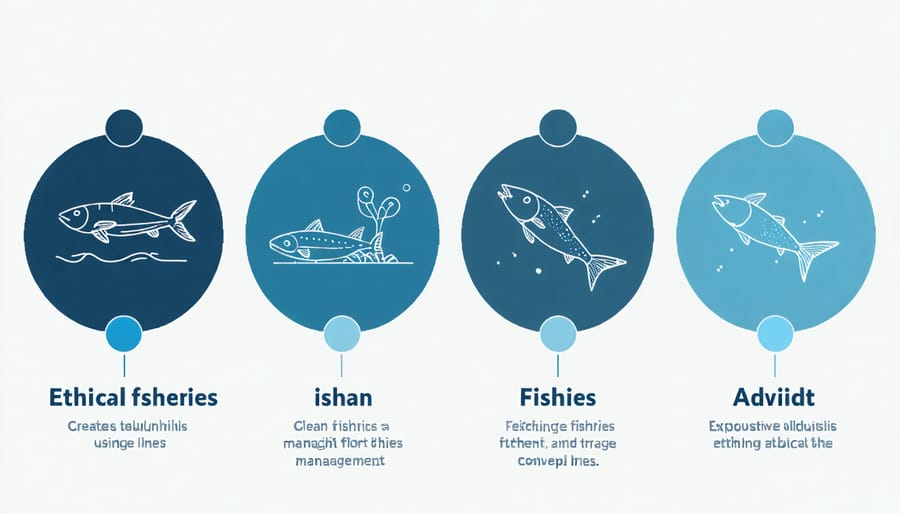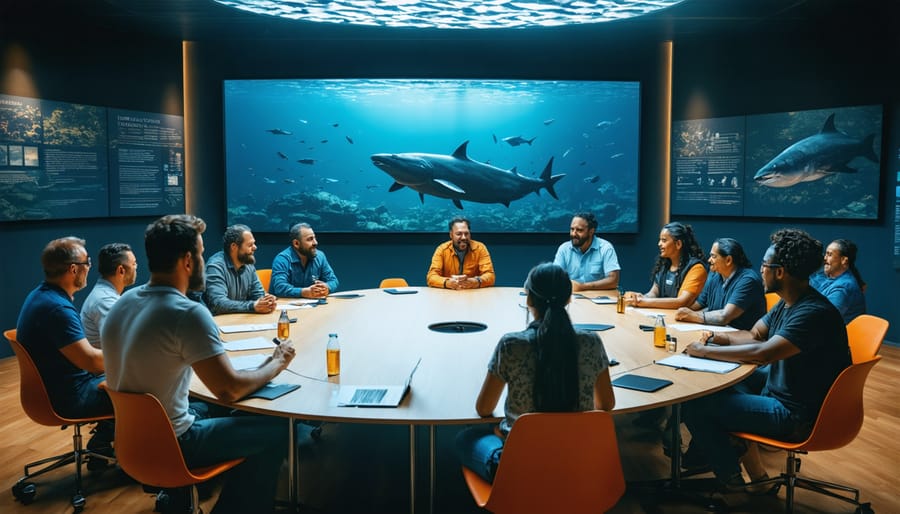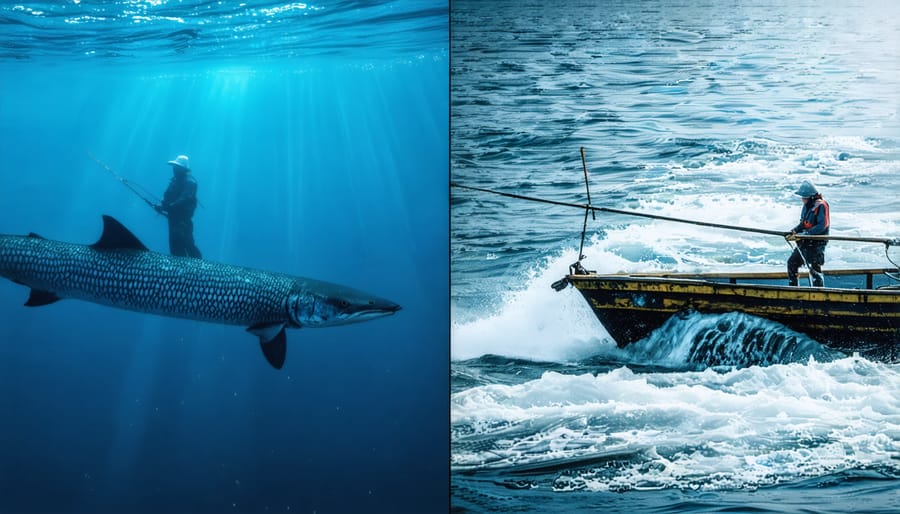
Establish clear ethical principles before making any marine resource management decision, ensuring alignment with ethical ocean conservation principles and stakeholder values. Map potential consequences of each decision across multiple time horizons, considering impacts on marine ecosystems, coastal communities, and future generations. Balance competing interests through structured stakeholder engagement, using documented criteria to weigh ecological preservation against socioeconomic needs. Create accountability frameworks that measure outcomes against established ethical standards, enabling continuous refinement of decision-making processes.
Making ethical decisions in marine conservation requires more than just scientific data—it demands a systematic approach that considers long-term ecosystem health, community wellbeing, and intergenerational equity. This framework provides fisheries managers and conservation professionals with practical tools to navigate complex moral challenges while maintaining transparency and scientific rigor. By incorporating both quantitative metrics and qualitative values, decision-makers can develop solutions that serve both environmental sustainability and social justice objectives.

The Four Pillars of Ethical Fisheries Management
Environmental Stewardship
Environmental stewardship forms a crucial pillar in ethical decision-making, particularly when addressing marine ethics considerations and ecosystem management. This responsibility extends beyond simple conservation to encompass a holistic understanding of ecological interconnections and their long-term implications.
Decision-makers must evaluate the impact of their choices on biodiversity, habitat preservation, and ecosystem resilience. This includes considering both immediate effects and potential long-term consequences for future generations. Key factors to assess include habitat disruption, species interactions, and the maintenance of ecological balance.
Successful environmental stewardship requires integrating scientific data with traditional ecological knowledge and local community insights. This collaborative approach helps ensure that conservation efforts are both effective and culturally sensitive. Practitioners should prioritize solutions that minimize environmental harm while supporting sustainable resource use.
Regular monitoring and adaptive management strategies allow for continuous improvement and response to changing environmental conditions. By incorporating these principles into the decision-making framework, organizations can better fulfill their role as guardians of natural resources and champions of biodiversity preservation.
Social Justice
Social justice in ethical decision-making focuses on ensuring fair distribution of benefits and burdens across all stakeholders while protecting vulnerable populations. In marine conservation, this means considering how management decisions affect local fishing communities, indigenous peoples, and future generations.
A key principle is equitable access to resources. When implementing conservation measures, we must balance ecological preservation with the needs of communities who depend on marine resources for their livelihood. This includes developing alternative income sources or compensation mechanisms when restricting fishing activities.
Meaningful stakeholder engagement is essential. All affected parties should have a voice in the decision-making process, from small-scale fishers to large commercial operations. Special attention should be paid to traditionally marginalized groups, ensuring their perspectives and traditional ecological knowledge are valued and incorporated into management strategies.
Intergenerational equity is another crucial consideration. Our decisions today must preserve marine resources and ecosystem health for future generations while addressing immediate social and economic needs. This requires long-term thinking and careful evaluation of trade-offs between current use and future sustainability.
Economic Viability
Conservation efforts must be balanced with the economic realities facing coastal communities and fishing industries. Sustainable economic opportunities can coexist with environmental protection when properly managed. For example, eco-tourism initiatives have successfully created alternative income streams for former commercial fishers while protecting marine ecosystems.
The key lies in developing economic models that incentivize conservation rather than exploitation. This might include certification programs for sustainable fisheries, which allow producers to command premium prices while maintaining healthy fish populations. Community-based management programs have demonstrated that when local stakeholders have a direct economic stake in conservation, they become powerful advocates for environmental protection.
Investment in sustainable aquaculture and marine biotechnology presents another avenue for economic growth that, when properly regulated, can reduce pressure on wild populations. Training programs can help fishing communities transition to these alternative livelihoods while preserving their connection to marine resources.
Success requires careful analysis of market forces, community needs, and ecological impacts to create solutions that benefit both the environment and local economies. Regular monitoring and adjustment of economic initiatives ensures they continue to serve both conservation goals and community prosperity.
Cultural Preservation
Traditional fishing practices and indigenous knowledge systems represent invaluable cultural heritage that has sustained marine ecosystems for generations. These time-tested methods often embody a deep understanding of local marine environments and sustainable resource management. When developing ethical frameworks for fisheries management, it’s crucial to incorporate and respect these traditional practices.
Indigenous communities worldwide have developed sophisticated systems for maintaining fish stocks while preserving marine biodiversity. These include seasonal fishing rotations, traditional gear designs, and customary marine tenure systems that effectively manage access to fishing grounds. Their holistic approach often considers not just the target species, but the entire ecosystem’s health.
Modern fisheries management can benefit significantly from integrating this traditional ecological knowledge with scientific methods. For example, the Pacific Islands’ traditional fishing calendars have proven remarkably accurate in predicting fish spawning periods, while Aboriginal Australian communities’ traditional marine management practices have helped preserve reef ecosystems.
Ethical decision-making frameworks should create space for meaningful dialogue with indigenous communities and traditional fishers, ensuring their voices are heard and their rights protected. This collaborative approach not only preserves cultural heritage but also enhances the effectiveness of marine conservation efforts.
Implementing the Decision-Making Framework
Stakeholder Identification and Engagement
Effective ethical decision-making in marine conservation requires thorough identification and engagement of all stakeholders who may be affected by or have influence over conservation initiatives. This process begins with comprehensive mapping of both direct and indirect stakeholders, including local fishing communities, indigenous peoples, marine tourism operators, environmental organizations, government agencies, and scientific researchers.
To identify stakeholders, conservation managers should conduct community surveys, analyze resource use patterns, and review historical data about marine area usage. Special attention must be paid to marginalized groups who may have traditional rights or dependencies on marine resources but limited representation in formal decision-making processes.
Engagement strategies should be tailored to each stakeholder group’s needs and capabilities. This might include organizing community forums, establishing advisory committees, conducting one-on-one interviews, or creating digital platforms for feedback collection. For traditional fishing communities, engagement might involve informal meetings at local gathering places, while scientific stakeholders might prefer structured workshops or technical conferences.
Successful stakeholder engagement requires:
– Clear communication channels
– Transparent information sharing
– Regular updates on project progress
– Opportunities for meaningful participation
– Recognition of diverse perspectives and knowledge systems
– Mechanisms for conflict resolution
– Documentation of engagement processes and outcomes
By fostering inclusive participation and maintaining open dialogue, managers can build trust, ensure fair representation, and develop more effective and equitable conservation solutions that benefit both marine ecosystems and human communities.

Impact Assessment
Evaluating the potential consequences of our decisions is crucial in marine conservation. Impact assessment tools help us understand both immediate and long-term effects of our choices on marine ecosystems and stakeholder communities. One effective approach is the Consequence Matrix, which maps potential outcomes across environmental, social, and economic dimensions.
Start by identifying all stakeholders affected by the decision, from local fishing communities to marine species. Then, assess both direct impacts (like changes in fish populations) and unintended environmental impacts (such as shifts in ecosystem balance).
The DPSIR framework (Drivers, Pressures, State, Impact, Response) offers another structured approach to evaluation. This tool helps trace the chain of cause and effect from human activities to environmental changes and societal responses.
Consider both short-term and long-term consequences using scenario planning. This involves mapping out different possible futures based on various decision paths. For example, when evaluating fishing quotas, examine scenarios ranging from strict conservation measures to more flexible management approaches.
Quantitative tools like risk assessment matrices can help assign probability and severity scores to different outcomes. These scores can then guide priority-setting and resource allocation. Remember to incorporate indigenous knowledge and local expertise alongside scientific data for a more comprehensive assessment.
Regular monitoring and feedback loops ensure that impact assessments remain dynamic and responsive to changing conditions in marine ecosystems.

Case Studies in Ethical Decision-Making
Let’s examine two real-world scenarios where marine conservation professionals faced complex ethical decisions. In the first case, a team of researchers studying endangered sea turtles discovered a previously unknown nesting site. While publishing their findings would advance scientific knowledge, it could also attract poachers to the vulnerable location. The team applied the ethical decision-making framework by first identifying their core values: scientific transparency and species protection. They consulted local conservation authorities and community leaders, evaluated potential consequences, and ultimately decided to publish their findings with modified coordinates while implementing enhanced monitoring systems.
The second case involved a marine protected area manager facing pressure to allow limited commercial fishing in a recovering reef ecosystem. Local fishers argued for their traditional rights, while conservation data suggested the reef needed more time to regenerate. Using the framework, the manager facilitated stakeholder discussions, gathered scientific evidence, and considered both short-term socioeconomic impacts and long-term ecological benefits. The solution emerged through collaborative decision-making: establishing a graduated access program that allowed sustainable traditional fishing practices while maintaining critical protection zones.
These examples demonstrate how the framework helps balance competing interests and values. In both cases, decision-makers identified clear ethical principles, gathered relevant information, considered multiple perspectives, and developed creative solutions that addressed both conservation goals and stakeholder needs. Their success relied on transparent communication, inclusive consultation processes, and a commitment to finding balanced, sustainable outcomes that served both environmental and community interests.
The implementation of robust ethical frameworks in fisheries management is not just a theoretical exercise but a crucial step toward sustainable ocean governance. By integrating ethical marine management strategies into decision-making processes, we can better balance conservation needs with socioeconomic interests while preserving marine ecosystems for future generations.
Success in this endeavor requires commitment at all levels – from individual fishers to international governing bodies. The frameworks discussed provide a roadmap for navigating complex ethical decisions, but their effectiveness ultimately depends on consistent application and regular evaluation of outcomes. We must remain adaptable, incorporating new scientific findings and stakeholder feedback to refine our approaches.
As marine conservation professionals, we have both the opportunity and responsibility to champion these ethical frameworks. By engaging with local communities, supporting research initiatives, and advocating for transparent decision-making processes, we can create lasting positive change in fisheries management. The time to act is now – our oceans’ future depends on the ethical choices we make today.
Take the first step by implementing these frameworks in your organization and sharing your experiences with the broader marine conservation community. Together, we can build a more sustainable and ethically-managed marine environment.
jessica
Ava Singh is an environmental writer and marine sustainability advocate with a deep commitment to protecting the world's oceans and coastal communities. With a background in environmental policy and a passion for storytelling, Ava brings complex topics to life through clear, engaging content that educates and empowers readers. At the Marine Biodiversity & Sustainability Learning Center, Ava focuses on sharing impactful stories about community engagement, policy innovations, and conservation strategies. Her writing bridges the gap between science and the public, encouraging people to take part in preserving marine biodiversity. When she’s not writing, Ava collaborates with local initiatives to promote eco-conscious living and sustainable development, ensuring her work makes a difference both on the page and in the real world.
